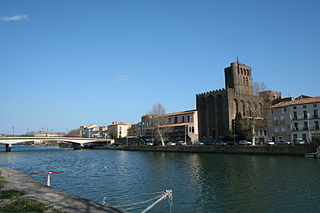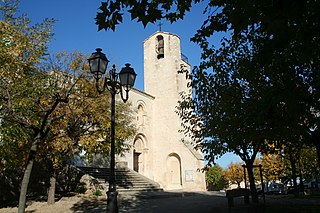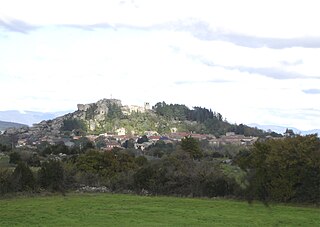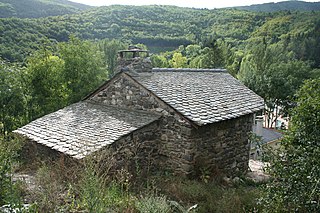
Hérault is a department of the region of Occitania, Southern France. Named after the Hérault River, its prefecture is Montpellier. It had a population of 1,175,623 in 2019.

Agde is a commune in the Hérault department in Southern France. It is the Mediterranean port of the Canal du Midi. It is situated on an ancient basalt volcano, hence the name "Black Pearl of the Mediterranée".

Assas is a town and commune in the Hérault department, region of Occitania, southern France.

Saint-Guilhem-le-Désert is a commune in the Hérault department in the Occitania region in Southern France. Situated where the Gellone river's narrow valley meets the steep-sided gorge of the river Hérault, Saint-Guilhem-le-Désert is essentially a medieval village located on the Chemin de Saint-Jacques pilgrim route to Santiago de Compostella.

Clermont-l'Hérault is a commune in the Hérault department in southern France.

Bédarieux is a town and commune in the Hérault department in the region of Occitanie in southern France. The town is surrounded by the Espinouse mountain and Orb river, and is in the Haut-Languedoc Regional Nature Park.

Pézenas is a commune in the Hérault department in the Occitanie region in southern France.

The arrondissement of Béziers is an arrondissement of France in the Hérault department in the Occitanie région. Its INSEE code is 341 and its capital city is Béziers. It has 153 communes. Its population is 309,800 (2016), and its area is 3,091.2 km2 (1,193.5 sq mi).

Saint-Thibéry is a commune in the Hérault département in the Occitanie region in southern France.

Gigean is a commune in the Hérault département in Occitanie in southern France.

Le Caylar, also known as Le Caylar-en-Larzac, is a commune in the Hérault department in southern France, in the administrative region of Occitanie. It has the Village étape label since 2013.

Arnac-sur-Dourdou is a commune in the Aveyron department in the Occitanie region of southern France.

Pouzolles is a commune in the Hérault department in the Occitanie region in southern France.

Caux is a commune in the Hérault department in southern France.

Villeneuvette is a commune in the Hérault department in the Occitanie region in southern France. It is close to the town of Clermont l'Hérault.

Saint-Pons-de-Mauchiens is a commune in the Hérault department in the Occitanie region in southern France.

Le Pouget is a commune in the Hérault department in the Occitanie region in southern France. It contains the Gallardet dolmen.

Jean Bène was a lifelong politician in France and a leader in the French Resistance.

The canton of Pézenas is an administrative division of the Hérault department, southern France. Its borders were modified at the French canton reorganisation which came into effect in March 2015. Its seat is in Pézenas.

The Departmental Council of Hérault is the deliberative assembly of the Hérault department in the region of Occitanie. It consists of 50 members from 25 cantons and its headquarters are in Montpellier.




































